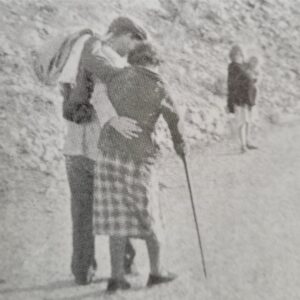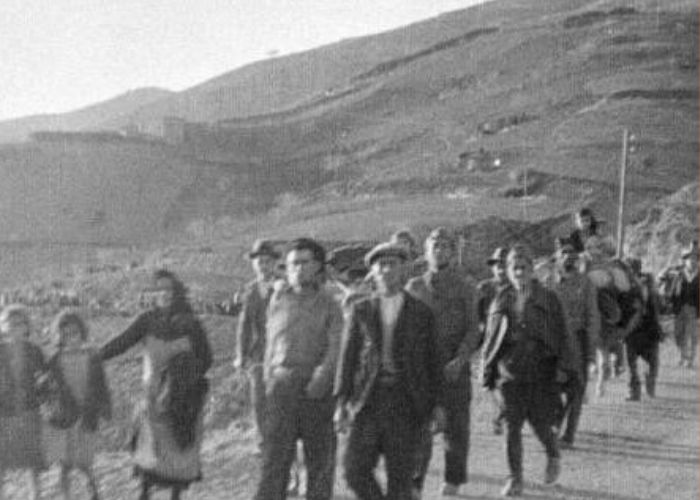ALMERIA – 86 years ago a major humanitarian disaster occurred on the road from Malaga to Almeria. Fleeing disaster in the form of Franco’s approaching troops, some 150,000 citizens of Málaga decided to pack their belongings.
Their target was the city of Almería, around 200 kilometres further west, where Franco’s troops were still conspicuous by their absence. On Monday morning, February 8, 1937, the Nationalist troops invaded Malaga. They were aided by German and Italian troops. And together, they invaded the city with tanks, warships and planes. Due to the lack of weapons and other equipment, the defences of Malaga were soon knocked out. Consequently, the fascist nationalists found a practically deserted city. Only one road led all these men, women and children to their “freedom”. It was bordered on one side by the high peaks of the Sierra Nevada and on the other by the sea. It was the largest and most terrible forced evacuation of its time.
Five days of hell

Young persons in good shape can walk forty or fifty kilometres a day. However, the journey these women, children and old people had to undertake would take at least five days and nights. There was no food to be found along the way and there were no trains or buses to transport the refugees. There was nothing for it but to walk. During the day in the burning sun and at night suffering cold along the road, covered only by scanty blankets. Moreover, while these civilians, dragging each other and their meagre belongings, made their way to a haven, they were fired upon from the sea and bombed from the air.
Norman Bethune
Some insight into the agony endured by thousands of people can be obtained thanks to survivors and Norman Bethune, a Canadian surgeon who was there. He had come to Spain as a volunteer to fight against the fascists. He joined the health service of the International Brigade in 1936. After visiting all aid stations, he set up a mobile blood bank to prevent unnecessary deaths due to a lack of blood. With his mobile laboratory, Bethune transported the blood of donors to the front. Eventually, he ended up in Andalucia. There, along with his two assistants Hazen Sisen and Thomas Worsley, he provided aid to the civilians in the wake of Franco’s victories.
The refugees
When Bethune drove from Almería to Málaga to help after the fall of this city, he encountered the beginning of this refugee flow. That was a terrible sight, although the strongest people and those who were lucky enough to have horses and donkeys or carts moved there. As Bethune’s mobile unit advanced, what they found was more horrifying. The Canadian doctor and his colleagues started donating blood to the injured.

Children
They saw thousands of people, including around 5,000 children under the age of 10. Many of those children walked without shoes and had too few clothes on. They hung exhausted over adults’ shoulders or were dragged along by their mothers. About eighty kilometres from Almeria, the crowd was so large that Bethune’s bus could barely get through.
They also heard that the fascists were very close. Therefore, they dismantled the blood bank and drove back to safety with as many of the worst off as possible. A difficult task, because whom should they choose? The bus was approached by panicked mothers and desperate fathers holding up their children with outstretched arms. Faces swollen by the sun and covered with dust from days on the road. “Please take this child with you,” “this one is injured.” Children with bloody rags around their bodies, feet swelled to twice their size, crying hopelessly from pain, hunger and fear. Two hundred miles of misery. For four days and four nights, they hid in the hills while the fascists pursued them relentlessly.
Impossible choices
Bethune and his colleagues had to choose between the worst cases. But how could they choose between a dying child and a mother holding her newborn against her bleeding belly? It had been born on the road two days before. A delivery for which she stopped walking for only ten hours. Or an old woman who couldn’t possibly take another step with enormously swollen legs with burst veins, bleeding all over her sandals. Many old people simply gave up the struggle and sat or lay by the road waiting for death.
The doctor and his assistants decided to take only children and mothers at first. But that resulted in too bitter scenes. How to separate the children of their fathers, or wives of their husbands? It got too horrible. In the end, they took families with the largest number of young children and children without parents, of which there were already hundreds.
Those who were there
Cristóbal Criado Moreno, age 16 in 1937
“We were very hungry. In the beginning, just after the departure from Málaga, there was still food, but after two days of walking, there was nothing left. We ate what we could find. At one point we found a bag of flour with which we made porridge with salt and water.
We heard from other people from surrounding villages that people had wanted to flee there, but were too late and were shot.
Suddenly the planes were there. At Cuesta de los Caracolillos, they started bombing us. People tried to hide. My family was gone. I was standing next to a pier in the harbour. Bombs hit very close. I saw death everywhere. Found my family again but we lost my little sister and we had to move on without her.”
Natalia Montosa Roa, age 14 in 1937
“We heard that the fascists had closed the road in Motril and returned to Málaga. Along the way, we saw many dead, including hanged ‘milicianos’ (volunteers on the Republican side) and an entire family with bullet wounds. Indeed, many chose suicide over falling into the hands of the nationalists. My mother’s feet were hurt and she couldn’t go on.”
Miguel Escalona Quesada (10 years old in 1937)
“We saw a lot of misery. Passed a flood of refugees, all exhausted and starving. In such a bad state that from afar they mistook a raven for an aeroplane and fled in all directions in panic. After days of walking, we also had no shoes left.
I will never forget the woman who, wounded by a shell, breastfed her son of a few months in the middle of a pool of blood.”
Rosende Fuentes Ayllon (12 years old in 1937)
“What I saw then on the road to Almería, I saw again many times later and I continue to see it. On television and in newspapers. What happened in Málaga was an example of what would be repeated later in other wars. But this was the first time that civilians were attacked and bombed in this way. Málaga was occupied and there was a trap at the exit”.
The barbaric outcome
Over the next days and nights, Bethune and his colleagues drove about thirty people without stopping to the hospital in Almeria, where medical attention, food and clothing were provided. Their tireless efforts saved many lives.
Yet the real barbarism was yet to come. Pursuing and bombing the unarmed, fleeing civilians on their long journey was not enough for the fascists. The small port of Almeria was packed with 40,000 exhausted refugees. All assumed they were finally safe. Precisely at that moment, on the evening of February 12, 1937, Almería was heavily bombed by Italian and German aircraft.
The alarm siren sounded just thirty seconds before the first bomb fell. The pilots deliberately dropped ten large bombs right in the centre of the city, where the exhausted refugees were packed so close together that hardly a car could get through. Bethune held three dead children in his arms after the planes took off. Just before that, they were queuing for a glass of milk and a piece of dry bread, the only thing they would eat for days.
Streets filled with the dead and dying
The streets of Almeria were filled with the dead and dying. The moans and screams of the wounded and their loved ones, and people searching for each other in frantic panic, gradually faded into “one mass cry of horrible intensity,” Bethune wrote in his notes.

The only crime these people committed was that they had chosen a different government. The reason why thousands of people decided to leave Malaga was that they knew what would happen to their wives and husbands. They preferred to walk to their deaths rather than patiently await the massacres, torture and brutal rapes of the Nationalist troops.
Sources: Pamphlet by Norman Bethune, Publicaciones Iberia, Madrid, February 1937
Norman Bethune, ‘El crimen de la carretera Málaga-Almería (Febrero de 1937), Caligrama Ediciones, Benalmádena, 2004
Also read: Spain withdraws postmortem medals from Franco´s executioner


